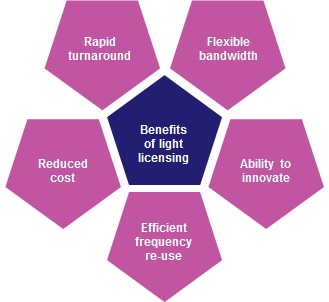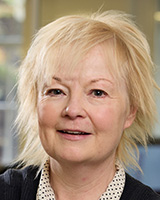E-band spectrum offers strong prospects for new wireless services, and effective regulation can unlock innovative uses
Frequencies in the millimetre-wave portion of the radio spectrum above 60GHz offer favourable properties for providing high-capacity wireless links. This is primarily due to the large amounts of spectrum available in the millimetre-wave portion, compared to lower-frequency bands – the large amounts of spectrum make wide channel widths a possibility, to achieve very-high-capacity links. This is emerging as a key driver for commercial use of millimetre-wave bands. In particular, the E-band, which is a millimetre-wave band including the frequencies 71–76GHz and 81–86GHz internationally, is emerging as a popular choice for point-to-point wireless links in markets where this spectrum is available. E-band is part of the extremely high frequency (EHF) portion of the radio spectrum (broadly 30GHz to 300GHz), corresponding to wavelengths between 1mm and 1cm, hence the term ‘millimetre waves’.
However, despite being internationally allocated for fixed services use, the E-band is not yet available for licensing in all markets and, where it is available, a variety of licensing approaches have been used, risking divergence in terms of the regulatory conditions for use of this valuable resource.
The properties of E-band frequencies, particularly the available bandwidth and the channel sizes (which, being in multiples of 250MHz, offer scope for considerably higher capacity to be delivered per link than is possible in other frequency bands allocated for fixed services use), make this band ideally suited to meeting growing demand for high-capacity point-to-point and point-to-multipoint wireless links. Demand for use of this spectrum comes both from within telecoms networks (e.g. for backhaul) and to provide high-capacity wireless connectivity to businesses and consumers, as well as in the context of new and innovative uses beyond conventional fixed point-to-point links.
In particular, the short wavelength of frequencies in the E-band means that the potential for interference between neighbouring links is reduced compared with lower-frequency bands typically used to provide point-to-point links.
Technological developments in use of millimetre-wave bands have also resulted in the availability of highly directional antennas for use in E-band. These ‘pencil beam’ antennas not only make it possible to simplify co-ordination between links (due to reduced risk of interference) but they also potentially improve the performance of links in terms of their directionality and range.
The properties of E-band frequencies and the use of ‘pencil beam’ antennas mean that regulators have much more scope to implement simplified co-ordination mechanisms for the licensing of links in E-band, compared to other frequency bands used for point-to-point services where links are individually co-ordinated and frequency and location-specific licences are issued by the regulator.
In view of this, a number of regulators have chosen to open up E-band for use on a self-co-ordinated (also referred to as a ‘lightly licensed’) basis. The first lightly licensed approach to E-band was in the USA, and a number of other markets have subsequently adopted similar approaches. At least two regulators that we are aware of (in the Czech Republic and Mexico) have removed the need for frequency co-ordination for E-band altogether, and provide access to E-band on a licence-exempt (unlicensed) basis.
The use of these self-co-ordinated management approaches has the benefit of facilitating a quicker turnaround on licence applications (useful, since one of the main benefits of fixed radio links is that they can be deployed more rapidly than wired connections). Self-co-ordinated licensing also has the potential to reduce access costs for using the spectrum (i.e. spectrum fees), if regulators do not need to recover the cost of administering detailed frequency assignment and interference assessment within the fee for the links.
At present, the main use of E-band is for terrestrial point-to-point wireless links. However, the self-co-ordinated management approaches that regulators are increasingly adopting could support the emergence of more innovative applications – as evidenced in the USA, where experimental licences filed for E-band use by Google demonstrate possible new uses that may emerge in future1.
Overall this suggests a range of benefits emerging as further regulators choose to open up E-band for use on a lightly licensed basis, as indicated below.
Figure 1: Benefits of self-co-ordinated, light licensing in E-band [Source: Analysys Mason, 2016]

Despite clear benefits from opening up E-band on a lightly licensed basis, use of E-band frequencies is still emerging in some markets (and the band is yet to be opened for use in other markets, despite an allocation for link use that applies internationally). In certain markets, E-band has been made available, but is licensed using traditional point-to-point licensing approaches, whereby individual links are co-ordinated and frequency and location-specific licences are issued by the regulator. While this approach might have merit in some cases (e.g. providing greater certainty of interference-free operation) it may potentially dampen ability to offer innovative services in E-band, since it introduces additional regulatory co-ordination overheads, resulting in increased time needed for licensing, and potentially higher costs.
With the E-band being a relatively nascent market, it is too soon to conclude that increasing demand for use of the band is being influenced by the licensing approach. However, it is to be expected that the self-co-ordinated, light licensing approaches being implemented in a growing number of markets should reduce the cost and administrative barriers for new users to deploy systems in E-band, encouraging uptake. This increasing uptake in use is unlikely to compromise the integrity or usability of the E-band, thanks to its physical properties. Overall, the attractive properties of this frequency band – including the simplified licensing approaches being used – are likely to spur further innovative technology development for use of this band in future.
1 http://arstechnica.com/gadgets/2016/01/google-tells-the-fcc-its-secret-airborne-network-is-nothing-to-worry-about/
Authors

Janette Stewart
Partner, expert in spectrum management, policy and valuationLatest Publications
Podcast
Future trends and challenges in spectrum policy for mobile networks
Project experience
The case for replacing ALFs for UK mobile licensed spectrum
Report
Impact of additional mid-band spectrum on the carbon footprint of 5G mobile networks: the case of the upper 6GHz band

